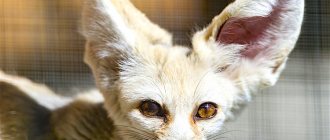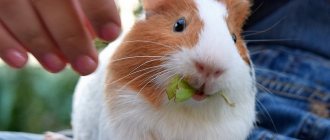The Fennec fox is a very popular animal recently, which is often kept at home. You can learn about all the secrets of the content from the article.
Many people are interested in whether a little Fenech, who lives in the wild, can become the favorite of the whole family at home? The answer to this question is positive. But before you get a fox, you need to have an idea of how to care for it, how to feed it, and what conditions it needs. You will also have to find out in advance how this animal behaves at home, what it needs for normal existence and development.
Domestic Fennec fox: description
- Fenech is a miniature animal that belongs to the genus of foxes in the canine family. The animal, if translated from Arabic, is called “fox”. But the scientific name of the animal is “dry fox.”
- It is from this that you can understand where exactly the animal lives. Places where the fox is found: the desert of the Arabian Peninsula, as well as in many regions of Africa.
- To this day, there is a dispute between scientists - can this animal be called a “fox”? Since the behavior of the animal, its body structure differs from other varieties of foxes.
- The fennec fox does not have the musk glands that other foxes have. She does not like to live alone; this animal is considered social.
fox
is a small animal. It has the following distinctive body features:
- The fox is even smaller than a domestic cat. The height at the withers is no more than 22 cm. The animal’s body is maximum 40 cm long. But the fox’s tail is long, sometimes reaching the same size as the whole body. Fenech's weight is no more than 1 kg 500 g.
- The fox has a pointed muzzle , but its eyes are quite large.
- The animal's ears are large. They can be up to 15 cm in height. But nature did not give these ears to the fox for luxury. Thanks to them, the animal can hear any smallest rustle, and therefore never misses its own prey.
- Fenech can be without water for a long time. But at the same time, the fox must always have food that contains liquid. The main feature of Fenech’s behavior is the ability to jump up to 1 m 20 cm in length and up to 70 cm in height.
Briefly
Description and colors
The most common and beloved color of the domestic fox is red.
The domestic fox breed has two main colors - red and black-brown. But there are also pure white specimens, although more often the white color is present in the form of cute “collars” and “socks”.
The weight of a silver fox or red fox reaches 6 kg. Females are usually larger than males.
The muzzle of the domestic variety is less elongated than that of the usual one and has a rounded shape. The ears are drooping, the tail is slightly curved upward.
It has also become fashionable to keep a fennec fox, an African desert fox, as a pet. Fenechs differ from ordinary ones in their tiny size (2 kg), huge ears (15 cm) and extremely long tail (30 cm).
The big ears and cute face of the fennec cat will not leave anyone indifferent
Such proportions might seem strange and even ugly, but not in this case. An extremely cute creature with expressive eyes on an elongated, lop-eared muzzle has long won the hearts of the local population.
The color of the coat of the African fox is not as bright red as that of its common relative, and is as close as possible to the color of sand for camouflage. The fur on the belly is white. By the way, fennecs are born entirely white and turn yellow as they grow older.
The big ears and eyes of the fennec cat are a clever idea of nature. The size of the eyes allows the desert fox to be a vigilant night hunter, and the increased ear size plays the role of a kind of air conditioner, cooling the animal’s body in hot desert conditions.
Fenech Fox: care and maintenance at home
- can be easily tamed at home It is easy to maintain; with normal care at home, a fox can even give birth to offspring.
- If you pay attention to the little animal, raise it correctly, and tame it at home, the animal will become obedient. But there are some difficulties in keeping a fox.
- You will have to purchase a large cage or create a separate room with sand on the floor. There the fox will dig a hole for himself.
- A long, difficult period of training Fenech to the tray . If you do not change the sand on time, there may be a bad smell in the house.
- Sometimes it is very difficult to find a specialist who can treat this exotic animal.
- The Fennec fox , like a pet, requires special attention. Due to its easy-going nature, the animal easily gets along with any inhabitants of the home and with other pets.
At home
- But we all know that the fox is a nocturnal inhabitant, therefore, at night its instinct of a real hunter awakens. The animal digs holes in the dark, runs around rooms, and sweeps away everything in its path.
- Make sure that the animal has enough space or even a separate room where the fox will feel comfortable.
Drafts and low room temperatures can be dangerous for your pet. Colds are difficult for foxes to tolerate and cannot always be cured. Therefore, give the animal the necessary vaccinations so that it does not develop an infectious disease.
The raw meat debate.
There is a debate about whether to feed raw meat to a pet fox. If you choose this type of diet, you must make sure that you feed them all the prey. This includes whole chickens, rabbits, mice and squirrels, depending on the protein content of the foxes in the wild. Instead of one breast or one thigh, foxes need the entire housing to benefit from unique protein nutrients.
Feeding the Fennec fox
- In nature, in the wild, the Fennec fox prefers to eat small animals and insects. The diet also contains roots and herbs that grow mainly in the desert.
- Under natural conditions, Fenech eats locusts, beetles, lizards, birds and their eggs, rodents and other small animals . And the fox eats plants only in small quantities. Conclusion: the animal’s diet consists mainly of protein foods.
- At home, you should follow the same dietary rules. If you feed your pet incorrectly, various health problems may arise. The fox's body is built in such a way that it does not process a lot of plant fiber. Keep this in mind, and do not forget, if you give the animal a lot of plant food, it will have problems with digestion.
Nutrition
- In addition, this cute animal has weak jaws and small teeth that are adapted for chewing insects. The animal's nutrition will be closer to its natural diet, and it will feel and develop better. But if the animal’s diet lacks small mammals and insects, it may develop liver disease.
- Your fox should eat large quantities of mealworms, crickets
- Give your fox lean meat in its raw state all the time. If possible, give small mice.
- additional food is vegetables (fresh or frozen). The maximum serving is 2 tsp per day. Please note that the animal should not be given corn, carrots, or grains. The fox's body does not digest such food well.
Catering
- Give fruits in minimal quantities. The animal should receive some treats.
- dried fruits (figs or dates). She will also love cherries.
- But do not forget that Fenech’s main diet should consist only of meat products. The animal needs a diet that contains a lot of protein.
- Keep an eye on the animal's feces. If your fox constantly eats grains and vegetables, you will notice undigested particles of these products in the feces.
- If you have doubts about the animal’s nutrition, you think that it does not receive enough vitamins and minerals, give the fox Vionate . You need to give vitamins only 2 times a week.
- Also add taurine , which comes in capsules. Open one capsule and add the powder to vegetables or worms. Give it like the previous drug.
Protein-rich foods work well
In nature, foxes hunt small animals, especially rodents. From the very beginning, foxes learned hunting techniques to move quickly and catch their prey. In captivity, a pet fox should be given protein-rich meals containing taurine .
A pet fox's natural diet will include mice, small rats, and rodents . Fennec foxes are commonly associated with a diet of smaller mice and rodents, while red or Siberian foxes may even devour a small rabbit. Regardless of the protein source, it is a fact that foxes need meat.
Insects can also be a good source for feeding your pet fox. These include grasshoppers, crickets, beetles and mealworms. Larger insects may also be available for pet owners to feed their fox; ask your local pet store.
How to litter train a Fennec fox?
- A miniature fox, as a rule, lives in a separate room or in a large cage. If you want to train your pet to use a litter box, you will definitely succeed, but some difficulties cannot be ruled out. Sometimes “misses” can happen, especially if the pet is in an excited state.
- There are some animal owners who trained the Fennec fox to wear a diaper. You can use this method if your pet will be constantly in one place.
- Who is better to buy - a girl or a boy Fenech ? What role do spaying and neutering play?
Fennec at home
- If you take a female, then after sterilization her character does not change at all. The same cannot be said about males. They become calm and affectionate.
- Males are by nature more obedient than females. The latter, as a rule, are shy and very nimble. When accustoming a female to the tray, keep in mind that after sterilization, the animal’s urine becomes less pungent in smell.
Other foods to avoid
Green potatoes are rich in solanine, chaconine and glucoalkaloids, which increase the level of toxins in the body. The tuber meat contains many toxins that can harm your pet. Another source of toxins are leaves, stems and berries of tomatoes . Macadamia nuts and walnuts can also cause weakness, vomiting and trembling...
Onions, garlic and chives should also be avoided as they belong to the allium genus, which can cause a toxic reaction to your pet fox. Why is this so? They include a sulfur compound called disulfide, which can damage red blood cells if consumed in large quantities. Dehydrated foods and meats should be avoided.
How does the Fennec fox play?
- These foxes are quite talkative. They make sounds reminiscent of a dog barking. Fennec foxes also “purr”, sometimes growl, and even snarl. Fennec foxes sometimes make beautiful sounds, similar to birdsong. They do this at night.
- The fox periodically howls pitifully, whines, and grumbles when she wants to play, have fun, and communicate. If you come home and call Fenech to play, the animal will begin to squeal loudly with pleasure.
- At night the fox loves to make noise. Therefore, give her a room located away from the bedroom. There are also quiet individuals. They are able to make calm sounds when greeting their owner in the morning.
You can play
- Many owners let Fenech out of the cage at night so that the animal can walk around the apartment. But it's better not to do this. An unattended fox grabs everything in its mouth, so it can choke.
- Also, the fox often tries to play with its owners and scratch itself with sharp claws.
- But there are Fennec cats that can adapt to the owner’s daily routine. At night they sleep.
If you buy a Fennec fox, you can easily train it to play only during the day. Take care of your pet during the day, in the evening, and play with him. You will notice that by night the animal will run out of energy and the pet will want to sleep. This way, over time, you will teach him to play and lead an active lifestyle only during the day.
- If a fox is constantly alone, it barks. There are also individuals who never do this. They can make sounds that resemble yelps.
- Fenech can yap when excited (while walking outside, when playing with the owner, and so on).
Fox breeding is a forgotten branch of fur farming
09/04/2019 Clothing made from natural fur has not lost its popularity for many centuries. In addition to aesthetic and decorative functions, it plays a protective role, especially in countries with cold and long winters. During the times of Kievan Rus, fur trade occupied one of the main positions in trade turnover with many European countries.
Centuries passed, but the demand for fur products did not decrease over time, which determined the high prices for this type of product. With a decrease in the number of animals in their natural habitat, fur farms became an alternative to hunting, where they raised fur-bearing animals, including foxes, in specially created conditions.
Unfortunately, over the past decades, this industry has declined, although fur products still remain at the peak of popularity during the cold season, so my next few articles are devoted to the peculiarities of growing and breeding fur-bearing animals. In addition to the previously described minks, rabbits and nutria, which are raised to obtain valuable and beautiful fur, in our climate it is possible to breed foxes, arctic foxes, raccoons, and ferrets. There will be several future articles about the rules of keeping, feeding, and caring for them, but today we’ll talk about foxes.
According to the biological classification, the fox belongs to the order of predators, the canine family, and the genus of foxes. The red fox is very common in the wild. In addition to her, black-brown and silver-black foxes are also bred on fur farms. Both dark variations in the color of the animal's fur appeared as a result of mutational changes in the color of the fur of the common fox and the South American fox.
Black foxes were not very rare before, as evidenced by some ancient documents that contain records of purchases of black foxes and their skins. Images of these animals are often found in heraldry: on the coat of arms of Prince Edward Island (Canada), the cities of Salekhard, Surgut, Totma (Russia), etc. The dark tone of the color arose as a result of a spontaneous mutation - the guard hair acquired a black color.
After a long selection work with mutated individuals, modern fur breeders managed to fix the black color and create two varieties of dark fur of foxes: black-brown and silver-black. They are very similar and differ only in shades. The black-brown has a well-defined reddish-brown tint to the hair of the head, ears, withers, sides, and hips. The silver-black has a silvery fur tint - this is ensured by the presence of white areas on the black guard hairs. Due to the fact that when looking at the fur from different angles, the white areas visually merge, and against the black background of the rest of the fur, they create a silvery tint. Today in the world there are 11 variants of the color of black foxes.
All foxes are fire
,
silver-black
,
black-brown
- can interbreed with each other and produce crossbred offspring, the fur color of which is usually intermediate between the color of both parents. Crosses of black foxes with red foxes are called differently: bastards, sivodushki, zamarayki, krestovki. Crossbred foxes do not have a color standard, but most often they have the following coloring features: the tail is always darker than the body, there is a black mark in the form of a mustache on the upper lip, the paws are black up to the elbow and hock joints, and a narrow black stripe stretches along the edge of the thigh all the way to the body . Sometimes, during the breeding process, white-motley animals appear.
The fox has a very characteristic and always recognizable appearance. The body length of an adult animal, excluding the tail, reaches 80 cm. Females are always slightly smaller than males and have a leaner body structure. The weight of a fox is about 5 – 6 kg, some males can sometimes grow up to 9 kg! The constitution of most fox representatives is strong. These animals have a predominant active, easily excitable, balanced temperament.
The fur all over the fox's body is approximately the same length, thick, on the back it is darker and stiffer (especially in males), the tone of the fur on the belly and chest is lighter. The guard coat of the back and sides of red foxes is bright red to red; the undercoat is gray, with a bluish tint. The belly and lower chest are gray, with a white stripe in the center. The front of the neck is usually pure white. The legs are long, the fur on their lower parts is black. The length of the tail is from 40 to 55 cm, it is covered with thick and coarse hair, white at the end.
Foxes live up to 16 years, but it is advisable to keep them on a farm until they are seven years old. In older individuals, their reproductive characteristics (the number of cubs in the nest, their survival rate, the milk production of mother foxes, the regularity of estrus, fertility, etc.) deteriorate, and the quality of the offspring decreases.
The fertility of foxes on fur farms averages 5.7 fox cubs per female. Their survival rate under good conditions of housing, feeding and care is up to 93.2%. Black foxes reproduce better in industrial breeding conditions and are more caring mothers than red foxes.
You can keep foxes in cages, enclosures, rooms, but the most practical and common way is in a shed. The shed consists of two parallel rows of large cages located under one common gable roof. A passage is left between the rows of cages for service personnel and equipment. The length of the shad can be arbitrary and depends on the needs of the fur farm. The ends of the shed are usually closed with blank walls and equipped with a door or double gates, and the sides are open. In unfavorable weather, the sides can be covered with temporary walls made of wooden panels, fabric, PVC or canvas curtains. It is better to make the floor with a hard surface - this way it will not deteriorate from prolonged use or dampness, and it is easier to clean.
The dimensions of the shed can be as follows: height along the roof ridge 3.1 m, width (at the edges of the roof) 4.1 m, passage width 1.7 m. The supporting structure is made of pipe with a diameter of 8 cm, and the supports-racks for placing cages are from a pipe with a diameter of 2.5 cm. The dimensions of cages for keeping foxes are as follows: height 0.7 m, width 1.2 m, length 3 m. In smaller cages, animals grow poorly, the fur becomes dirty, and the reproductive cycle of the parent herd is disrupted. Each cage should have a feeder, a drinker and a lockable hole leading to the nesting house. Manhole size: 30 cm × 30 cm.
An important component of successful fur farming is timely, high-quality feeding and food supply. Between February and October, foxes are fed twice a day: 40% of the daily requirement is given in the morning, and 60% in the evening. From November until the onset of pregnancy, females are fed once. During the warm season, the food should have a temperature of about +15°C, and in the cold season +25°C. This way it is better eaten by animals and does not spoil if left in the feeder for a while. There should be constant water in the drinking bowls.
To feed foxes, you can use bread, vegetables, and cereals, but the fox is a carnivorous animal, so the basis of its diet should be food of animal origin. Dairy products, eggs, meat, and fish are best suited for this. In practice, due to the high cost of such feed, they most often use slaughterhouse waste, offal, animal meat from forced slaughter, waste from fish processing plants, and incubators.
The main components of the daily diet of an adult fox can be as follows: meat - 350 g, eggs or hatchery dead - 2 pieces, liver - 30 g, fish - 30 g, cottage cheese - 30 g, blood - 40 g, porridge or bread - 50 g, chopped vegetables (excluding potatoes, since they are not digested in the body of foxes, but pass through in transit) - 30 g, meat and bone meal - 3 g, fish meal - 3 g, fish oil - 3 g.
It is recommended to feed foxes with a homogeneous food mixture, otherwise the animals will eat the offered food selectively. It is recommended to add vitamin preparations to the feed mixture. For example, you can add “Ganaminovit” (at the rate of 0.25 g of the drug per 1 kg of feed). It should be given for a week, after which a break of 1.5 - 2 months should be taken. For young animals intended for slaughter, for better fur quality, it is recommended to add feed sulfur to the feed mixture in a dose of 0.05 g per fox cub from July.
Rotten and low-quality feed should not be fed to animals. Rancid fat and moldy food are especially dangerous. Feeding large amounts of fish and offal reduces the quality of the fur, while feeding blood and silkworm larvae, on the contrary, improves the quality of the skins. Therefore, in the pre-slaughter period it is recommended to use the latter for feeding.
Foxes reach sexual maturity at approximately 10 months. Depending on the light regime in the room, feeding and maintenance conditions, this threshold can vary from 9 to 11 months. Since fox reproduction is seasonal (fox cubs are born at the beginning of the warm season), it is advisable to mate normally developed young animals during the first hunt, otherwise you will have to wait for the next hunt, i.e. another year! And given that the fox is a carnivore, keeping it “idle” is unprofitable.
Preparation of the parent herd of foxes for the breeding season begins in the fall. The owner should take care of good (but not excessive) fatness of the reproductive stock. When palpating the area of the back and sacrum in animals with optimal fatness, the bones are palpable, but do not protrude, and the layer of fat is small. The timing of seasonal molting can also indirectly signal the state of the body. Animals with insufficient fatness in order to increase their live weight need to be fed in the fall with more calories.
In the period from December to January, females that have been selected for further breeding must eat well, but their feeding must be planned in such a way that by the beginning of the rut (the period when foxes mate) they have lost about 5% of their weight. Females that have retained their previous fatness often experience low fertility, and the viability of their fox cubs is usually lower.
During the period from autumn to the start of the rut, all necessary planned activities that can cause stress in animals should be carried out, so as not to disturb the foxes during a crucial period of their lives. These include vaccination, anti-parasitic treatment, moving foxes to other rooms or cages, various repair work (updating wiring and equipment, rooms, cages), deratization, etc.
Young animals come into heat much later than adults, and to synchronize it, young foxes must be placed in the brightest part of the room or on the south side of the shed. The light regime greatly affects the reproductive function of foxes, so they cannot be kept in dark rooms, otherwise hunting may not occur at all. This is explained by the fact that their hormonal system functions depending on the duration of daylight hours. In both females and males, sex hormones that regulate sexual behavior are actively produced by the glands only at certain times of the year, the onset of which is indicated by the duration and intensity of daylight. During this period, their gonads even increase in size.
Foxes come into heat and hunt from the end of January to the beginning of April. The time of onset of estrus depends on the individual characteristics of the body of a particular fox, its age, feeding and maintenance conditions. The duration of sexual arousal in females lasts about a week, but the favorable period for fertilization is limited to several days, usually 2 - 3 days, it is during this period that the fox is ready to mate and allows the male to approach. If the female is not in a state of hunting, then the male fox does not try to cover her, and the female fox behaves aggressively with him.
For fertilization, a female with signs of estrus is placed daily with a male (and not vice versa!) until mating occurs. If mating has occurred, it is repeated two more times: after 12 hours and after 24 hours. This is done so that the maximum number of eggs that mature at the same time are fertilized. The number of fox cubs in the future litter depends on this. From the moment of the last covering, the fox is considered fertilized.
Pregnancy in foxes lasts 52 days, but fluctuations of 1–2 days are possible. There can be from 1 to 11 fox cubs in a nest, but more often there are from 5 to 6 of them. It is advisable to cull foxes that did not come into the hunt until the end of April or did not become pregnant and replace them with young ones next year. Sometimes some males turn out to be infertile, or even a full-fledged male can produce low-quality seed at the end of the rutting period, and then all the females covered by him remain unfertilized. Therefore, it is better to cover females not with one fox, but with several different ones, if possible. In this case, there is a greater chance of getting offspring without wasting time.
A fox's pregnancy can be diagnosed by palpating the belly on the 28th day. But this procedure requires great care and practical skills, otherwise palpating the embryos can lead to abortion. It is much safer and easier to simply watch the covered fox carefully. A couple of weeks after mating, the female’s appetite noticeably increases, her shape is rounded due to the active deposition of protein and fat in the muscles.
The reserve of nutrients is created especially intensively before the 26th day of pregnancy, therefore, in the first half of pregnancy, the female cannot be limited in food; feeding should be plentiful. Young foxes that will whelp for the first time need more food than adults. On the 35th – 37th day, the fertilized fox becomes calm, cautious in its movements, less mobile, and spends more time dozing. The abdomen in the back part drops, the mammary glands become noticeable. On the 45th – 46th day, the abdomen noticeably enlarges and the mammary glands become full.
A week before the expected birth, a nesting house is connected to the cage, half filled with soft straw from awnless varieties of cereals, and the cage itself is well cleaned and disinfected. Before giving birth, the fox should not be disturbed: make noise, transfer it to another cage, etc. Feeding should be of high quality and timely. 5-6 days before giving birth, the fox’s appetite decreases (this is normal, as it should be), during this period it is better to reduce the volume of its daily intake and give it, in addition to regular food, easily digestible food: liver, dairy products, blood.
A few days before whelping and immediately after it, females’ need for water increases, so a whelping (pregnant) fox must have drinking water constantly, otherwise after giving birth she may eat her cubs. Foxes are very sensitive to stress; any unfavorable conditions can cause abortion. Another pattern has been noticed that termination of pregnancy and abortions occur more often in those females who were covered in later stages. Females fertilized in winter usually have no problems during pregnancy. Before giving birth, colostrum appears in the fox's nipples, most females change their behavior: they build a nest of straw in the nesting house, worry, and tear out the fur on their bellies. Some people partially pluck the hair on the tail and sides.
Sometimes the fox runs around the cage, crouches, looks at its stomach, and worries. This is a sign that the female is unable to give birth and needs veterinary attention. This cannot be done without a qualified veterinarian. The foxes will be born in the morning or at night. If everything went well, then 20–30 minutes after birth the cubs are already suckling their mother. In the first days after giving birth, the fox is constantly in the nesting house, only occasionally going out into the cage to drink and eat. The squeak of fox cubs is periodically heard from the nesting house, which immediately fades away.
In a normal situation, fox cubs lie in a heap in the nest, most of the time they sleep or eat. If a constant creaking squeak is heard from the house, and newborn fox cubs crawl along its bottom, then this is a sign that the fox either has little milk or does not give it to them, and human help is needed. Sometimes it happens that maternal instinct and milk do not appear immediately in a fox. This is especially true for young primiparous females.
In such a situation, the nesting house should be opened and the brood inspected. In this case, the fox cubs may be cold, scattered throughout the nesting house, with dull, disheveled fur, weak, inactive, or, conversely, overly active. Sometimes they remain wet, their tummies are taut, and the umbilical cord is poorly dried. Such puppies need to be wiped dry, warmed and, holding the fox, the newborns should be applied to her nipples, starting with the weakest babies.
For better milk production, the fox can be given a subcutaneous injection of the hormonal drug Oxytocin 10–15 minutes before. If there is still no milk, then it is better to place the fox cubs one at a time or two in the nests of other foxes that whelped during the same period, and discard the milk-free mother.
It is necessary to place fox cubs in someone else's nest, taking certain precautions, otherwise the stepmother fox may not accept the newcomer and eat him. The animal should not observe manipulations with the introduction of foundlings, so first the entrance to the nest box is blocked with a flap so that the fox remains in the cage at this moment. To successfully receive a fox cub by a nurse fox, it must be carefully rubbed with the down of the receiving nest and, placing it in the center of a pile of fox cubs, left for 30 - 40 minutes. During this time, being between the cubs of the receiving nest, the foster fox will have time to acquire their scent. After this time, we open the hatch of the nesting house and let the komilitsa fox approach the cubs.
Some foxes do not accept other people's cubs, despite all the measures and precautions taken, but in most cases the procedure is successful. If it is not possible to transfer the fox cubs to other nests, then they have to be fed artificially. But in any case, everything possible must be done to ensure that newborn fox cubs receive at least some amount of mother’s colostrum on the first day, otherwise they may die.
The point here is that for a newborn fox, colostrum is not only a source of nutrients. We can give them to him as part of an artificial milk formula or cow's milk. Colostrum contains one very valuable and artificially unique component - live antibodies produced by the mother’s body, which create passive immunity specifically to the microflora of a particular fur farm. A newborn fox cub does not yet have its own immunity, and the antibodies obtained from the mother’s colostrum initially protect it from pathogenic microorganisms. Without colostrum, the baby fox most likely will not survive.
After birth, on the second or third day, it is advisable to examine and count the fox litter. You should not do this only if you are sure that there are no problems in the nest (the fox is old and has proven many times that she is a good mother) or if the fox is very restless and easily excitable (may, due to your intervention, eat hers from stress). brood). Before inspection, the fox must be distracted with a treat and the entrance to the nest house must be closed with a flap, and hands must first be thoroughly washed without soap and wiped with fluff from the nest.
Normally, fox cubs are warm, well-fed, covered with smooth, shiny fur, their tummies are round, and their umbilical cord is dried out. These foxes don't need any help. If a lot of fox cubs are born, then over time it will be difficult for the mother to feed them: in a couple of weeks, when the cubs grow up, their appetite will increase, and mother’s milk may not be enough. In a large litter, fox cubs usually grow worse and become smaller than in a small litter. Therefore, if there is such a possibility, it is advisable to place several fox cubs from a large litter in the first days of their life into low-fertility litters of the same age, while observing the precautions already described.
Even during the examination, you should pay attention to whether the fox cubs have dangerous signs of “red feet.” It manifests itself in newborns in the form of noticeably thickened (edematous) paws, on the pads of which hemorrhages are visible. After a couple of days, scabs form at the site of the hemorrhages, and without veterinary care, the fox cubs die on the 4th - 5th day of life.
“Redfoot” of fox cubs is a consequence of an imbalance in the fox’s diet during its pregnancy, and especially with a lack of vitamin C. To avoid this phenomenon, special attention should be paid to feeding the entire parent herd of foxes and pregnant females in particular. You can help the “red-footed” fox cubs. To do this, they need to drink 1 ml of a 2% ascorbic acid solution from a syringe or pipette two to three times a day for several days until the paws become normal in appearance.
A lactating (milk-feeding) fox can be fed in the first week in the same way as before giving birth. The fox cubs' need for milk during this period is small, and feeding the fox abundantly will lead to an increase in the amount of milk that the fox cubs will not be able to drink. In this case, mastitis may occur, which is very undesirable.
Starting from the second week, lactating foxes should be fed ad libitum, three times a day, in equal portions. The better a fox eats, the better its cubs grow. A nursing fox should not be allowed to become severely exhausted; this may negatively affect the next reproductive cycle. A lactating fox cannot become fat, because everything is processed into milk.
For the first three to four weeks of life (depending on the milk production of the female), fox cubs feed only on their mother’s milk, and no human care is required. From about a month of age they need to start feeding. With dairy mothers and with a small litter, fox cubs do not need feeding longer. In foxes with low milk supply or in cases where the litter is large, the fox cubs have to be fed at an earlier date.
Typically, fox cubs at one month of age weigh 750–850 g, their weight depends on the milk production of the mother and the number of livestock in the nest. The first complementary foods are made from a mixture of minced horse meat, beef liver, eggs and milk. The mixture should be semi-liquid. When all the fox cubs begin to eat complementary food well, they begin to be given regular fox food ad libitum, without allowing competition for food.
By the age of one and a half months, all fox cubs should completely switch to independent feeding, and use mother's milk as an additive to the main diet. Normally developed fox cubs can be separated from their mother from 45 to 50 days of age, but it is better to do this at two months. If the female is milk-bearing, then it is better to place the cubs not all at the same time, but leaving one or three of the weakest ones for several days in order to avoid mastitis. If the female has little milk or is exhausted, then all the cubs are taken away at once.
In order to reduce stress in young animals caused by separation from their mother, they are placed two in one cage. Practice has shown that keeping one animal at a time leads to a decrease in growth rates, worse survival of the young and the development of inappropriately aggressive behavior in fox cubs in the future. Foxes can be placed in individual cages in August, when the young animals are divided into breeding and fur (commodity). Seating the animals one at a time is even desirable, since at this age young foxes begin to fight for leadership and territory, as a result of which the quality of the fur deteriorates due to bites.
The information described above applies more to black foxes. The red fox has some features that are inconvenient for artificial breeding. She is more susceptible to stress. Mating in representatives of this species takes place a month later than in silver-black and black-brown ones. Abortions and resorption of embryos in the early stages of pregnancy are more common among them than among black foxes. The fertility of red foxes is often lower, especially for young primiparous females. Their maternal instinct is also much worse expressed than among blacks. It is not uncommon to eat newborn fox cubs, scatter them, refuse to feed, etc., which is why the survival rate of red fox cubs is almost two times lower than that of black ones.
In addition, red fox cubs have poorer health than black ones. In the first three to four days, it is advisable for them to undergo subcutaneous injections of 0.5 ml of a maintenance mixture of the following drugs: serum against paratyphoid fever, colibacillosis of calves (200 ml); penicillin (500 units); monomycin (500 ml); vitamins B1 (2 ml), B6 (4 ml), B12 (10 ml). Also, all weak fox cubs should be fed once a day with a 10% glucose solution with ascorbic acid for three to four days.
Due to the fact that the milk production of the red fox is lower than that of the black fox, fox cubs begin to be fed from 20 to 25 days of age. In addition to the specified components, 1.5% powdered sugar should be added to the feed mixture. But the red fox also has several positive features: it is less sensitive to the composition of its diet and grows larger than the black one. Males can reach 7 kg, and females 6 kg.
After weaning and the entire transition period, it is very important to monitor the condition of the young animals, the food intake of the cubs and their behavior. If everything goes well, then the fox cubs grow quickly and at two months they weigh about 1750 - 1900. At three months they gain half the weight of an adult animal: 2.7 - 3 kg. In four their live weight reaches from 3.77 kg to 4.1 kg, in five it is 4.5 – 4.9 kg. The live weight and growth rate of young animals depend on the nutritional status and genetics of the animal.
The coat of fox cubs changes in accordance with their age and serves as an indicator of the correctness of their development, which depends on the quality of feeding and maintenance. Fox cubs are born with primary guard hair up to 7 mm long. By the end of the first week, they have a downy undercoat, the density of which increases by the age of three months. The guard coat grows to normal length by the age of one and a half months. At three months, the primary guard coat is replaced by a secondary one. In August, fox cubs begin to molt for the winter. The winter coat of fox cubs fully develops by October–November. During this period, commercial young animals are slaughtered for fur. Delay or advance in terms of development indicate disturbances in the feeding and maintenance of young animals.
When kept and bred on a farm, foxes should receive several vaccinations: against rabies (rabies vaccine), against leptospirosis and parvovirus enteritis (Multikan-8 vaccine), against canine distemper (Nobivak vaccine), against dermatomycosis (Vakderm vaccine "). In addition, do not forget about periodic treatments against helminths.
If you have any questions while reading this material, you can ask them on our forum.
Chuguevets Vitaly Share on social networks:
Fennec Fox: walking outside
- If you periodically walk your fox on the street, she will be happy to accompany you. You just have to understand that if an animal gets too cold, it can get sick. Therefore, during cold weather (autumn, winter), leave your Fennec fox at home.
- If you take your pet for a walk in the summer, be sure to take him out on a harness; you should not wear a collar. Fenech will break out of it, and therefore the animal can run far. In addition, you may encounter a situation where a small tug can damage your pet's neck.
Walks
- While walking, carefully monitor the animal. Dogs that walk on the street can cause aggression in Fenech. Therefore, walk the fox early in the morning or late in the evening.
One day from Vladivostok
Anna’s dream of an unusual animal came to her as a child, and her relatives often called Anya a fox for her red hair. Having grown up, the girl found out that there was a nursery in Vladivostok where you could buy a fox cub, and she was inspired by the idea of getting an exotic pet. Her parents and young man supported her, but her grandparents were against it - it takes a lot of strength to keep such an animal. Anna was not afraid of difficulties and now does not regret her decision to get a fox one bit.
“When Jessie was a month old, she was delivered to us by plane from Vladivostok; the flight with transfers took a whole day,” the girl recalls. “I started thinking about a nickname for my pet even before he was born—I made a whole list of names, but I couldn’t decide. As a result, the fox chose a nickname for itself: it began to respond to Jessie.
Jessie has been living with the family for 10 months, and the fox took three days to get used to its new owners and home. For the first time after the flight, she lay curled up in a ball and did not let anyone near her, but she soon realized that people would not harm her.
Fennec fox and other pets
- The Fennec fox is an animal that can get along with other pets. The fox will not make friends with those individuals that it can eat.
- Fenech loves to play with dogs and cats. But sometimes foxes may not share the interests of these animals. Yes, she will get along with them, but it is better not to leave the fox alone with these animals.
- Hamsters, rats, domestic and street birds will not be Fenech's friends - they will become excellent prey . Therefore, if there are birds and rodents in the apartment, it is better for Fenech not to meet them.
A beast with character
Of course, caring for such an animal requires a lot of effort, but Anna and her boyfriend are used to it. Jessie behaves like a dog, she even knows several commands. But at the same time, the red-haired beauty also has cat-like habits, for example, she loves to jump on the sofa. Jessie lives on the balcony, this is a convenient option for foxes: firstly, in winter, when the animal dresses in a warm fur coat, it is not as hot as in the apartment, and secondly, while the owners are away from the house, the fox can be closed so that it does not “I put the house in order.”
“Jessie taught us to be careful,” admits Anna, “you can’t leave anything unattended - the fox will drag it away... Therefore, we have to put all our things in the closet or on the top shelves.
Foxes are very active animals, so Jesse spends most of his time playing. In order to restore energy, a couple of minutes is enough for the red-haired beauty. The fox loves soft toys, but doesn’t mind having fun with its owners. Sometimes Jessie can bite, but she doesn’t do it too much - this is how she makes it clear that she doesn’t like something.
To the question “What sounds does a fox make?” difficult to answer. The girl notes that she usually yelps, although she can growl, whine, squeal, and squeak... The domestic fox eats dog food, fruits and vegetables. Sometimes while walking Jessie catches mice, and she brings the trophies to the owner.
Fennec fox at home: advantages, disadvantages
From the descriptions and characteristics of the Fennec fox, which were described above, only one conclusion suggests itself - keeping an animal at home has its pros and cons.
Advantages
- The fox is considered a decorative, exotic animal.
- The animal is active and loves to play.
- It is easy to care for.
- Fenech is not picky when it comes to nutrition.
- Gets along with many pets.
- If you care for a fox properly, it can live up to 15 years.
Advantages and disadvantages
Flaws
- Fenech is relatively expensive. You will have to spend a considerable amount at the first stage of the animal’s development.
- In order to tame a fox, you need a lot of time, patience, and effort.
- Fennec fox sometimes marks its own territory.
- The animal is often active at night.
- Often throws things around the house.
- It is difficult to find a doctor for an exotic animal if it is sick.
- There are aggressive individuals.
- If there is a small child in the house, you should not get a Fennec fox.
Red-haired cougars
Foxes
They do not limit themselves to any one dish; they can eat animals of more than three hundred different species.
The main part of the diet consists of voles, gophers and other small rodents. Therefore, it is believed that foxes provide significant benefits to agriculture by reducing pest numbers. Much less often, the fox is lucky when hunting larger game, such as hares. Hares occupy a small share in the diet of foxes, although predators do not miss the opportunity to feast on long-eared animals and quite often catch hares. And when the hare pestilence sets in, they do not disdain even corpses.
Birds play a smaller role than rodents in the fox’s diet, although the fox will never miss an opportunity to hunt any bird that flies down, both small and large, and does not shy away from laying eggs, small chicks, and destroys nests.
According to popular belief, foxes like to visit chicken coops for poultry, but this happens much less often than is commonly thought; predators are forced to do this by hunger when they cannot get other food. These raids cause much less harm compared to the benefits of reducing the number of rodents by foxes.
Fenech Fox at home: reviews
As a rule, many owners claim that it is possible to have a Fenech fox at home . It only takes time for the animal to get used to home conditions.
- Marina : “Many people are worried about whether this wild animal can be kept at home? Yes, you can. The fox does not pose a danger to other household members. But it will take time to accustom your pet to order. To begin with, we accustomed the fox to us, then to our dog. Then we decided to teach Fenech to go to the toilet in a litter tray and behave calmly at home. We spent several months on this. One huge plus, thanks to which you don’t regret spending time - keeping Fenech is a great pleasure.”
- Sergey : “If you decide to get this animal, evaluate your own capabilities. The animal needs its own doctor at least to get a rabies vaccination. Also keep in mind that raising a Fennec cat is a challenging task. It is necessary to accustom your pet to the tray, to walk during the day, but not at night. You will face many difficulties, but it will be worth it.”
- Svetlana : “Fenech is a beautiful, sweet fox. The animal is affectionate and kind. But for Fenech to get used to you, it will take a lot of time. You should also know that foxes often dig minks. If you do not make a room with sand for it, the animal may build a house under the bed or in the closet. The fox has wild habits, so try to create appropriate conditions for it.”
Fox food is prohibited
In general, the leaves, fruits, bark and seeds are rich in toxins. Persen , this can create breathing problems and cause fluid to accumulate in vital organs such as the heart. A dose of 150 mg of caffeine per kilogram of body weight can be fatal; Always keep caffeine away from your pet fox.
Another strict no-no chocolate contains a substance called theobromine, which can poison animals. It is a well-known fact that dogs cannot eat chocolate; the same applies to foxes, as dark chocolate can cause seizures, coma and even death. Find out why dogs can't eat chocolate to understand how it affects their bodies.
Grapes and raisins can cause vomiting, kidney damage and hypercalcemia in foxes. Traces of glycoalkaloids in tomatoes, peppers or eggplants can also harm your fox's well-being.
Enemies and friends
The fox belongs to the canine family, so it can get along well in the same area with dogs, but its relationship with cats is unlikely to work out the way you want; keeping them in the same room will not be easy. And, most likely, due to the fault of the latter.
Cats are generally jealous of the appearance of new inhabitants on their territory, and do not hide their emotions and their attitude; they begin to hiss, wave their paws, and even attack the uninvited guest.
If dogs are patient with the antics of their eternal opponents, then the fox can simply catch up and strangle the brute or rude woman, or at least give them a beating.
However, the relationship between pets depends on their individual characters.











